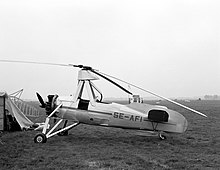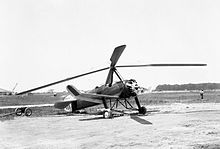Autogiro
The autogyro or gyrocopter is a rotary-wing aircraft, that is, it flies like airplanes but its wing is a rotor that rotates due to the action of the relative wind that goes through it from bottom to top. For this reason, it can be considered a hybrid between the airplane and the helicopter: like the airplane, its propulsion is carried out by means of a propeller, but, in addition to wings, it has a rotor like the helicopter. This rotor is not connected to the aircraft engine, so it rotates itself, propelled by the air, thus generating the lift force. In the helicopter, on the contrary, propulsion and lift are produced in the rotor, which is itself driven by the engine.
History
The gyroplane was the invention of the Spanish engineer Juan de la Cierva, who developed the articulated rotor that would later be used by helicopters (although it is passive, this system designed by Juan de la Cierva compensated for the difference in thrust of the beaten air, when the shovel goes forward, with the shake, when it goes behind, which caused both the gyroplane and the helicopter to overturn). In its first flight, the gyroplane managed to travel 200 meters in 1917 and later, it made the first trip between aerodromes from Getafe to Cuatro Vientos in 1918. It should be noted that Juan de la Cierva was never interested in helicopters, which he considered too complicated to fly and prone to accidents.
The first models of gyroplanes manufactured by Juan de la Cierva had small wings that acted as ailerons to control roll. Subsequently, its inventor introduced a joint in the head of the rotor and applied "direct control" to it, making the aforementioned wings unnecessary. Likewise, in the most advanced models, force could be transmitted from the engine to the rotor by means of a prelauncher, thus shortening the takeoff run, until reaching the "jump takeoff", practically vertical. The first prelauncher was designed by Heraclio Alfaro fournier. A later refinement was the so-called autodynamic rotor, introducing an angle with respect to the vertical in the drag joint, a system that kept the rotor blades in "fine pitch" until a certain speed was reached and the clutch was disengaged. the engine, at which time the blades moved in drag, sharply increasing their angle of attack, thus generating the necessary lift for the "jump takeoff".
The birth of helicopters led to the decline of gyroplanes until their virtual disappearance, although in more recent times there has been a certain resurgence among sports aviation, both by commercial initiatives and by fans who build their own gyroplanes. Experimental devices such as the Wallis WA-116 Agile, famous for its participation in the 1967 James Bond film You Only Live Twice, were also developed.
After several years of work at the Albacete Air Maestranza, on January 15, 1998, a Cierva C.30 gyroplane was flown again. It was piloted by Lieutenant Colonel Fernando Iglesia Manix. After an accident in June 2000, it was handed over to the Air Museum, located at the Cuatro Vientos air base (Madrid).
Autorotation with stopped motor
In the event of an in-flight engine stall, the gyroplane glides and begins to slowly descend, just like the seed of a sycamore tree, which has a propeller shape that makes it fall smoothly from the autorotating tree. The faster you do this, the faster the rotor blades spin, storing energy and providing more lift. Also in a helicopter, autorotation can be used to land without an engine, but the pilot has to act on the collective pitch and place the rotor in an autorotation mode. On the other hand, a gyroplane always flies in autorotation. It should be noted that for the blades to autorotate, the angle of attack must be negative.
Contenido relacionado
Air safety
Help:Interlanguage link
Pencil


